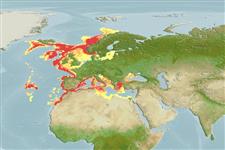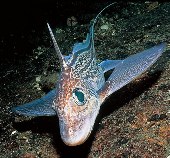Add your observation in Fish Watcher
| Native range | All suitable habitat | Point map | Year 2050 |

|
| This map was computer-generated and has not yet been reviewed. |
| Chimaera monstrosa AquaMaps Data sources: GBIF OBIS |
Upload your photos and videos
Pictures | Videos | Google imageChimaera monstrosa
Picture by Svensen, E.
Pictures | Videos | Google imageChimaera monstrosa
Picture by Svensen, E.
Denmark country information
Common names:
Europæisk havmus, Havmus
Occurrence: native
Salinity: marine
Abundance: | Ref:
Importance: | Ref:
Aquaculture: | Ref:
Regulations: | Ref:
Uses: no uses
Comments: Occurs in Skagerrak and northern Kattegat. Also Ref. 173.
National Checklist:
Country Information: https://www.cia.gov/library/publications/resources/the-world-factbook/geos/da.html
National Fisheries Authority:
Occurrences: Occurrences Point map
Main Ref: Muus, B.J. and P. Dahlstrøm, 1989
National Database:
Occurrence: native
Salinity: marine
Abundance: | Ref:
Importance: | Ref:
Aquaculture: | Ref:
Regulations: | Ref:
Uses: no uses
Comments: Occurs in Skagerrak and northern Kattegat. Also Ref. 173.
National Checklist:
Country Information: https://www.cia.gov/library/publications/resources/the-world-factbook/geos/da.html
National Fisheries Authority:
Occurrences: Occurrences Point map
Main Ref: Muus, B.J. and P. Dahlstrøm, 1989
National Database:
Common names from other countries
Classification / Names Nombres comunes | Sinónimos | Catalog of Fishes(Género, Especie) | ITIS | CoL | WoRMS | Cloffa
Holocéfalos (quimeras) (chimaeras) > Chimaeriformes (Chimaeras) > Chimaeridae (Shortnose chimaeras or ratfishes)
Etymology: Chimaera: Named for the mythological creature composed of parts of multiple animals, referring to their odd mix of characteristics (See ETYFish); monstrosa: Latin for strange or grotesque, referring to its strange appearance, as if composed of parts of multiple animals (See ETYFish).
More on author: Linnaeus.
Etymology: Chimaera: Named for the mythological creature composed of parts of multiple animals, referring to their odd mix of characteristics (See ETYFish); monstrosa: Latin for strange or grotesque, referring to its strange appearance, as if composed of parts of multiple animals (See ETYFish).
More on author: Linnaeus.
Environment: milieu / climate zone / depth range / distribution range Ecología
marino batidemersal; oceanodromo (Ref. 51243); rango de profundidad 40 - 1400 m (Ref. 104125), usually 300 - 500 m (Ref. 4443). Deep-water; 75°N - 27°N, 32°W - 35°E
Distribución Países | Áreas FAO | Ecosistemas | Ocurrencias, apariciones | Point map | Introducciones | Faunafri
Eastern Atlantic: northern Norway and Iceland, Skagerrak and Kattegat south to Morocco including western Mediterranean (some isolated records from eastern part), Azores and Madeira Islands. Records from South Africa are questionable. Reported from Oshima, Japan (FMNH 89161) (Ref. 27954).
Length at first maturity / Tamaño / Peso / Age
Maturity: Lm 45.9 range ? - ? cm
Max length : 150 cm TL macho / no sexado; (Ref. 35388); peso máximo publicado: 2.5 kg (Ref. 4645)
Max length : 150 cm TL macho / no sexado; (Ref. 35388); peso máximo publicado: 2.5 kg (Ref. 4645)
Bathydemersal to benthopelagic generally between 300 and 500 m depth. Found in the upper continental slope. Usually found in deeper waters in southern latitudes, while making a summer inshore migration up to 40-100 m in the northern areas. Sluggish, usually occurring in small groups. Feeds mainly on bottom-living invertebrates. The single dorsal spine is sharp and pointed, and although only mildly venomous can inflict a painful wound. Oviparous. Males have a clasper on the forehead that is probably used to hold on to the female during copulation. Egg capsules are about 17 cm long; young look alike adults and hatch when 10 cm long. Common by-catch when trawling for shrimps in the North Sea or Skaggerak.
Life cycle and mating behavior Madurez | Reproducción | Puesta | Huevos | Fecundidad | Larva
Oviparous; egg-capsules slender, club-shaped with narrow lateral membranes and a horny filament at the long pointed end, 17 cm long and 3 cm wide; deposited mainly in spring and summer. The embryos developing in about 9-12 months and hatch at 10 cm length.
Main reference
Upload your references | Referencias | Coordinador | Colaboradores
Krefft, G., 1990. Chimaeridae. p. 111-113. In J.C. Quero, J.C. Hureau, C. Karrer, A. Post and L. Saldanha (eds.) Check-list of the fishes of the eastern tropical Atlantic (CLOFETA). JNICT, Lisbon; SEI, Paris; and UNESCO, Paris. Vol. 1. (Ref. 4443)
IUCN Red List Status (Ref. 130435: Version 2024-2)
Vulnerable, ver lista roja de la UICN (VU) (A2bd); Date assessed: 02 September 2019
Human uses
Pesquerías: escaso valor comercial
FAO(pesquerías: producción; publication : search) | FIRMS (Stock assessments) | FishSource | Sea Around Us
Más información
Trophic ecology
componentes alimenticios
Composición de la dieta
consumo de alimento
Food rations
Despredadores
componentes alimenticios
Composición de la dieta
consumo de alimento
Food rations
Despredadores
Population dynamics
Coeficiente del crecimiento para
Max. ages / sizes
Length-weight rel.
Length-length rel.
Length-frequencies
Mass conversion
Reclutamiento
Abundancia
Coeficiente del crecimiento para
Max. ages / sizes
Length-weight rel.
Length-length rel.
Length-frequencies
Mass conversion
Reclutamiento
Abundancia
Life cycle
Reproducción
Madurez
Fecundidad
Puesta
Spawning aggregations
Huevos
Egg development
Larva
Dinámica larvaria
Reproducción
Madurez
Fecundidad
Puesta
Spawning aggregations
Huevos
Egg development
Larva
Dinámica larvaria
Physiology
Body composition
Nutrients
Consumo del oxígeno
Tipo de natación
Velocidad de natación
Visual pigments
Fish sound
Diseases & Parasites
Toxicity (LC50s)
Body composition
Nutrients
Consumo del oxígeno
Tipo de natación
Velocidad de natación
Visual pigments
Fish sound
Diseases & Parasites
Toxicity (LC50s)
Human related
Aquaculture systems
Perfiles de acuicultura
Razas
Ciguatera cases
Stamps, coins, misc.
Aquaculture systems
Perfiles de acuicultura
Razas
Ciguatera cases
Stamps, coins, misc.
Herramientas
Bio-Quiz | E-book | Guía de campo | Asistente para frecuencias de tallas | Herramienta de ciclo de vida | Mapa de puntos | Classification Tree
| Catch-MSY |
Special reports
Download XML
Fuentes de Internet
Aquatic Commons | BHL | Cloffa | BOLDSystems | Websites from users | Check FishWatcher | CISTI | Catalog of Fishes(Género, Especie) | DiscoverLife | ECOTOX | Faunafri | Fishtrace | GenBank(genome, nucleotide) | GloBI | GOBASE | | Google Books | Google Scholar | Google | IGFA World Record | MitoFish | Bases de datos nacionales | Otolith Atlas of Taiwan Fishes | PubMed | Reef Life Survey | Scirus | SeaLifeBase | Árbol de la vida | Wikipedia(Go, búsqueda) | World Records Freshwater Fishing | Zoobank | Expediente Zoológico
Estimates based on models
Preferred temperature (Ref. 115969): 3.7 - 14.1, mean 7.9 (based on 179 cells).
Phylogenetic diversity index (Ref. 82804): PD50 = 0.5000 [Uniqueness, from 0.5 = low to 2.0 = high].
Bayesian length-weight: a=0.00257 (0.00156 - 0.00424), b=3.01 (2.87 - 3.15), in cm Total Length, based on LWR estimates for this species & (Sub)family-body (Ref. 93245).
Nivel trófico (Ref. 69278): 3.5 ±0.0 se; based on diet studies.
Resiliencia (Ref. 120179): Bajo, población duplicada en un tiempo mínimo de 4.5-14 años (Assuming Fec <100;).
Fishing Vulnerability (Ref. 59153): High to very high vulnerability (68 of 100).
Climate Vulnerability (Ref. 125649): Moderate vulnerability (38 of 100).




